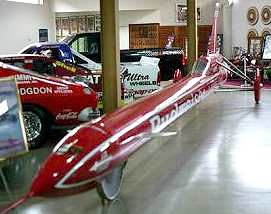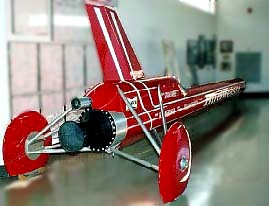|
BUDWEISER ROCKET CAR
AUTOMOTIVE A TO Z CLIMATE CHANGE EVENTS FUEL CELLS HYDROGEN SITE INDEX UTILITIES
The Budweiser Rocket was a 3-wheeled land vehicle powered by an hybrid liquid peroxide and solid-fuel rocket engine that is claimed to be the first vehicle to have broken the sound barrier on land (near sea level). There is much debate over the validity of the claim, and the Budweiser Rocket is generally not considered as the first vehicle to have broken the sound barrier on land.
Sponsored by Budweiser the Budweiser rocket car was built in 1979 with the intention of being the first land vehicle to break the sound barrier in the "Project Speed of Sound". On the 17th December 1979 the vehicle, driven by Stan Barrett, attempted to break the sound barrier and has left a legacy that has been controversial ever since as the final speed of the vehicle has always been disputed. It was believed that the car could exceed the speed of sound but when the vehicle was run no sonic boom was heard.
On December 17, 1979 Stan Barrett was strapped into the cockpit of the Budweiser rocket car waiting to make a final run in an attempt to be the first person to drive a land-bound vehicle faster than the speed of sound. Previous trials exposed shortcomings in the basic design of the car. The propulsion system was unable to develop enough power to accelerate the vehicle to a speed high enough to establish an official FIA or FIM sanctioned World Land Speed Record, which at that time stood at 622.
Hal Needham and the team must have reckoned that the rules for land speed racing were in fact obsolete and did not apply to their project. In the team's estimation the general public would not be able to distinguish a peak speed run from an official World Land Speed Record. If the general public accepted their logic and claim of being the first to exceed the sound barrier on land, it could be expected that corporate sponsors would pay a great deal of money for the chance to ride with history. The team in fact, claims a World Land Speed Record, while the Mach 1 event is a purely aerodynamic or atmospheric related phenomenon.
Their approach has generated arguments that may rage for quite some time and it is not the author's desire to debate it here. The only issues of critical importance are: did this car reach and exceed Mach 1; and is there evidence that can support such a claim?
The speed was estimated from a radar system at 38 miles per hour - though unfortunately this had been tracking a large truck in the distance, away from the track that the rocket car had used. Some hours after the run the speed (at the vehicle's peak) was calculated at 739.666 miles per hour, ( Mach 1.01 ). This however caused wide skepticism and the speed was never officially recorded.
The claim of breaking the sound barrier on land was made on December 17, 1979 after a run on Rogers Dry Lake at Edwards AFB. Even if the Budweiser Rocket did break the sound barrier, it cannot claim any official titles because standard ground speed record regulations ignore top speed and require a speed measured on either a kilometer or a mile, in tow directions.
The first run of the car at Bonneville showed that the propulsion system was unable to develop enough power to sustain a speed high enough to establish an new official World Land Speed Record. The team decided then that his goal to exceed the speed of sound on land, regardless of the fact that no official authority would recognize the achievement as a record.
The speed of sound is essentially a function of the air density. In other words sound barrier is not a absolute speed value, but dependent on air conditions. The speed of sound during Barrett's speed run was 731.9.
The measurement of the vehicle's top speed during the run has been disputed primarily of the methods used to calculate the speed, and its extremely small margin of success.
No independent authority was sanctioning the performance, the team was the only judge of his success or failure. The report on the speed came nearly eight hours after the run. The data of the run were interpreted as indicating a high degree of probability that the car exceeded the speed of sound by achieving a peek speed 739.666 miles per hour, or Mach 1.01. However according to witnesses no sonic boom was heard.
- Claimed speed: 739.666 miles per hour ( Mach 1.01 ) - Calculated - Released 8 hours after event - Eyewitness Testimony: no sonic boom was audible - Recorded radar speed: 38 mph ( recorded speed of truck nearby by accident) - Other recorded data: Accelerometer data from vehicle, images, other - Driver: Stan Barret - Other top speed claims: 638 mph in earlier attempt
The "Budweiser Rocket" is in the Talladega Super Speedway Museum, Alabama, USA. (circa 2004) The Thrust SSC is recognized as breaking the sound barrier in 1997, with a average speed of 763.035 mph (1227.99 km/h) on a mile.
LINKS & REFERENCE
https://
Copyright © website 2022, all rights reserved, save for educational and media review purposes. You do not need permission to use our information if it is to help promote a low carbon economy. This is a low carbon website that loads quickly and is as kept simple as possible while still providing useful information. Cleaner Ocean Foundation Ltd and Climate Change Trust.
|

